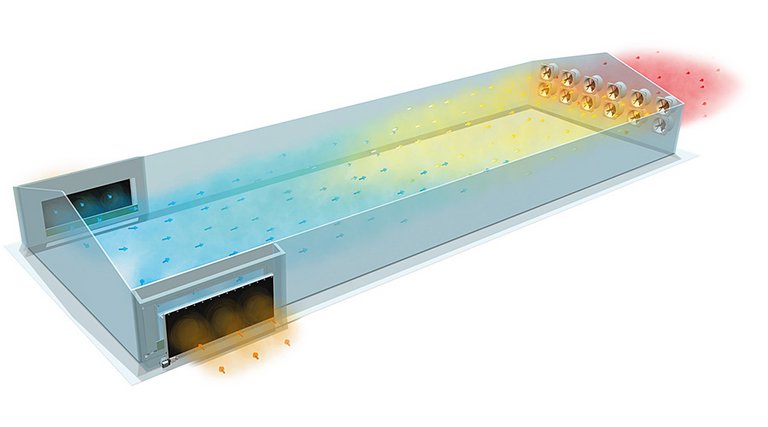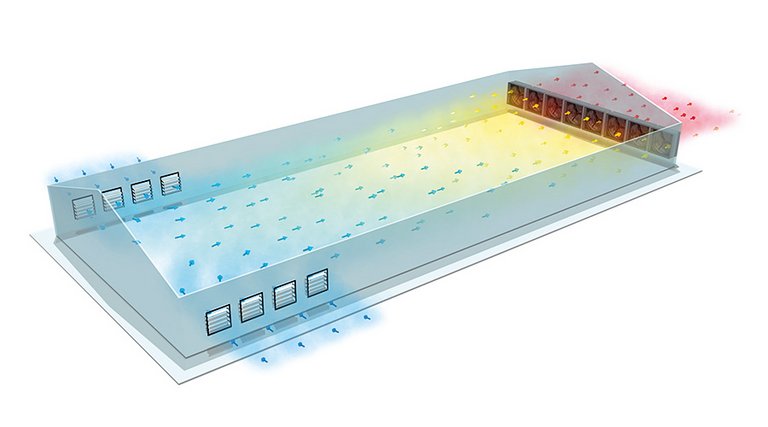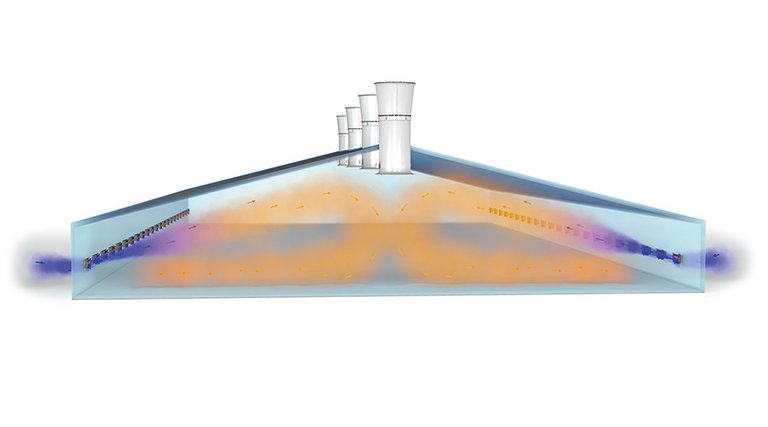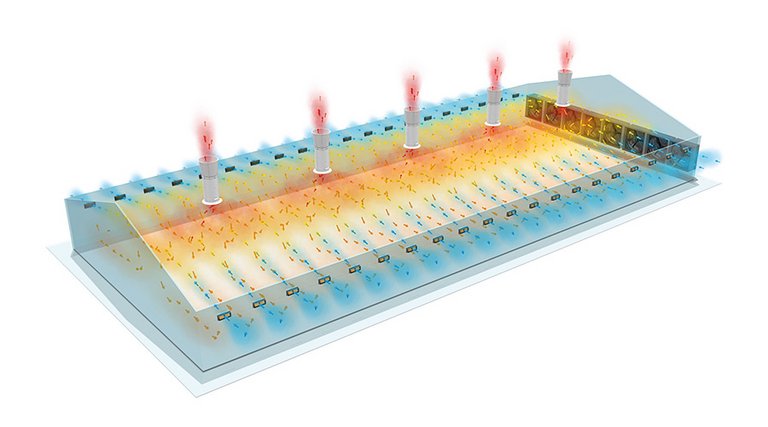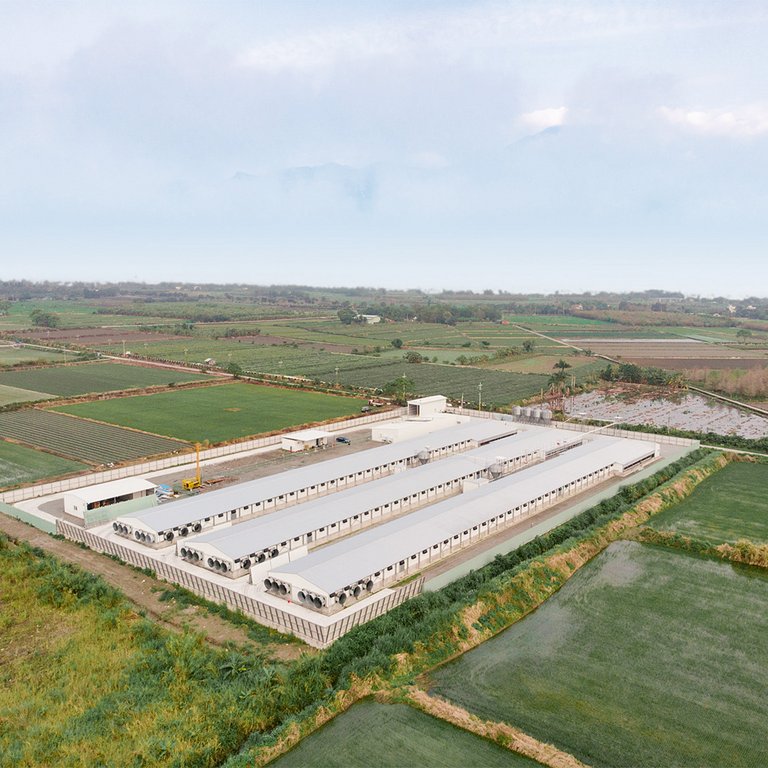Ideal climate conditions in poultry houses are important to provide the birds with temperatures that they perceive as comfortable. Only then will they stay healthy and be able to perform to their full potential. Depending on the region and its climate, two different ventilation systems have proven their effectiveness: tunnel ventilation and side ventilation. Both systems have important advantages, which nevertheless can turn into drawbacks under specific conditions, leading to the development of the so-called CombiTunnel ventilation. Today, CombiTunnel ventilation is the preferred option in more and more regions and comes with the corresponding recommendations.
Tunnel, side or CombiTunnel ventilation in poultry houses: when to use which system
Reconciling the climate outside and inside the barn
Tunnel ventilation is the most simple and, at the same time, the most efficient ventilation system for achieving high air speeds at bird level. Especially with high outside temperatures, a high air speed in the barn significantly reduces the temperature as it is perceived by the birds. This is called “windchill”: even with high temperatures and humidity, the birds are thus able to transfer excess body heat to the surrounding air. If temperatures continue rising, however, a high air speed alone is not sufficient. There is no more cooling effect when the difference between the outside air temperature and the birds’ body temperature is too small. In this case, the fresh air entering the house requires cooling.
Different cooling systems, e.g. spray cooling or pad cooling, are available for this purpose. Both systems lower the temperature of the fresh air, thus making the windchill noticeable once more. Heat stress can thus be prevented at any temperature. This keeps the birds’ performance at a steady and high level. Tunnel ventilation is the preferred system for poultry houses in regions that are usually hot. Heat stress and the accompanying excess water intake are prevented, and manure and litter remain dry.
Exhaust air fans are the most important component of tunnel ventilation systems. They must be able to withstand quite a high pressure in the barn. The longer the house and the higher the air speed, the more the counterpressure increases. Only very effective and pressure-stable fans can guarantee the necessary air change rate. Using a cone fan is also recommended because these fans are even more resistant to pressure.
At the other gable end or in its vicinity, large tunnel inlets are necessary to pull sufficient amounts of fresh air through the barn. Curtains, tunnel doors or shutters are all possible options. The inlets allow the fresh air to enter the barn over a large surface, displacing the stale air without mixing with it. At bird level, the air speed is even and high at around 2 to 3 m/s, creating the desired windchill.
Multiple-flap inlets are a good choice to control the air flow and air direction. When the inlets are no longer needed in the colder season, they close reliably. Additional insulation prevents temperature loss.
A third important component for tunnel ventilation is the cooling system. In addition to spray cooling, which is often used in broiler houses, a pad cooling system based on the principle of evaporative cooling is also an efficient option. The pads must not be made of cellulose, but of plastic: only plastic pads can be cleaned so the minerals that accumulate over time due to the water evaporating can be removed by a high-pressure cleaner. This keeps the counterpressure for the fans permanently low.
Another important benefit of plastic pads is that they work well even if the water quality is low, and they have a long service life. Only with plastic pads can the amount of water that is sprayed onto the pads be controlled, cooling the birds just as much as necessary without freezing them. This saves water and keeps the barn dry.
The purpose of tunnel ventilation is cooling, which is what it should be used for. It is not a suitable option at the beginning of the batch for broilers and pullets: the fresh air entering over a large surface would be much too cold and moist for the young birds.
Additionally, temperature differences between the air entrance and exit points are too great. The birds will get cold, start to become restless and consume more feed so they are able to produce more energy for self-preservation. In such a situation, side ventilation may be a good solution.
Side ventilation is the best ventilation system for achieving even temperatures throughout the barn. The fresh air enters the poultry house simultaneously along its entire length. The air streams first flow along the ceiling and then fill the entire interior.
This means that with low outside temperatures, the cold and moist fresh air can mix with the warm air in the barn before it reaches the birds. At the same time, the bird heat is used efficiently and less heating is required. Warm air can absorb the water vapour produced by the birds more easily. This vapour is removed by exhaust air fans in chimneys that are distributed over the roof of the building. This helps prevent too much air movement at bird level.
In regions where temperatures are often low, side ventilation is therefore the preferred system in poultry houses.
Fresh air inlets are the most important component of every side ventilation system. The perfect option are high-quality wall or ceiling inlets through which the fresh air enters the barn. Very accurate and simultaneous opening of these inlets is essential. They should also be able to close airtight. A large opening angle of the inlets, which can be operated by advanced inlet control, is also recommended. The target is the creation of a stable and circulating air flow so temperature conditions are the same for all birds in the house.
Apart from fresh air distribution, exhaust air removal is the next important aspect. Where centralised exhaust air extraction is desired or even required by authorities, tunnel fans in the rear gable are used.
This solution is very cost-efficient, but it has disadvantages because it creates different air speeds. The air is faster in the rear of the house than near the front, which means that the temperature perceived by the birds also differs.
In addition to decentralised fresh air distribution, the exhaust air extraction system should also be installed along the entire length of the house, especially for the first 2 to 3 m3/h of air flow rate per bird. It is then possible to achieve an even air speed and therefore a very uniform apparent temperature.
Exhaust air chimneys installed on the roof separate fresh air and exhaust air, which has a positive effect on hygiene. Moreover, the influence of the wind is significantly lower. When using chimneys with a motor-driven butterfly valve, a temperature-controlled emergency opening can be added to ensure that the birds survive in case of power failures.
However, there are also times when side ventilation is not the ideal system. If temperatures rise clearly above the comfort temperature, there is no sufficient cooling effect in the barn. The birds start to pant and consume more water, feed consumption decreases and laying hens, for example, produce fewer and smaller eggs.
CombiTunnel ventilation is an intelligent combination of tunnel ventilation and side ventilation. This combined system makes it possible to cover a wide range of temperatures. CombiTunnel ventilation is therefore the ideal option for all climate zones and ensures the health and vitality of the birds – without missing out on their potential. The farmer can reap important economic benefits, including a good feed conversion rate and low mortality.
Assuming that all previously mentioned components are installed in the barn, only one essential part is missing: the climate computer. Without a modern control system, even the best fresh and exhaust air elements are of no use.
Prerequisites also include the corresponding sensors in the house to measure important parameters such as inside and outside temperature, inside and outside humidity, air pressure in the house and CO2 and NH3 concentrations in the air. A modern climate computer should be able to use PID control, i.e. maintain exactly the desired temperature in the house. Switching steplessly and automatically from one ventilation mode to the other is also important and should occur based on criteria that have been pre-defined by the farmer. If the farmer focuses on dry litter and manure, ventilation will remain in side mode for as long as possible, for example.
It should also be possible to customize the view on the computer’s screen in both tunnel mode and side mode. Depending on the type of bird and production, requirements may be very different.
Today’s state-of-the-art technology is a fast and clear overview that shows all important climate values on a large and coloured touch screen. Most often, the climate computer is a production computer as well, meaning it also displays information regarding feed and water consumption and many other production data.
If a farmer wants to prevent heat stress while using bird heat efficiently at the same time, purchasing a combined ventilation system pays off. Taking into account the ongoing climate change as well, CombiTunnel can be the perfect option, offering the birds ideal climate conditions in the barn and thus meeting the requirements for secure production.


